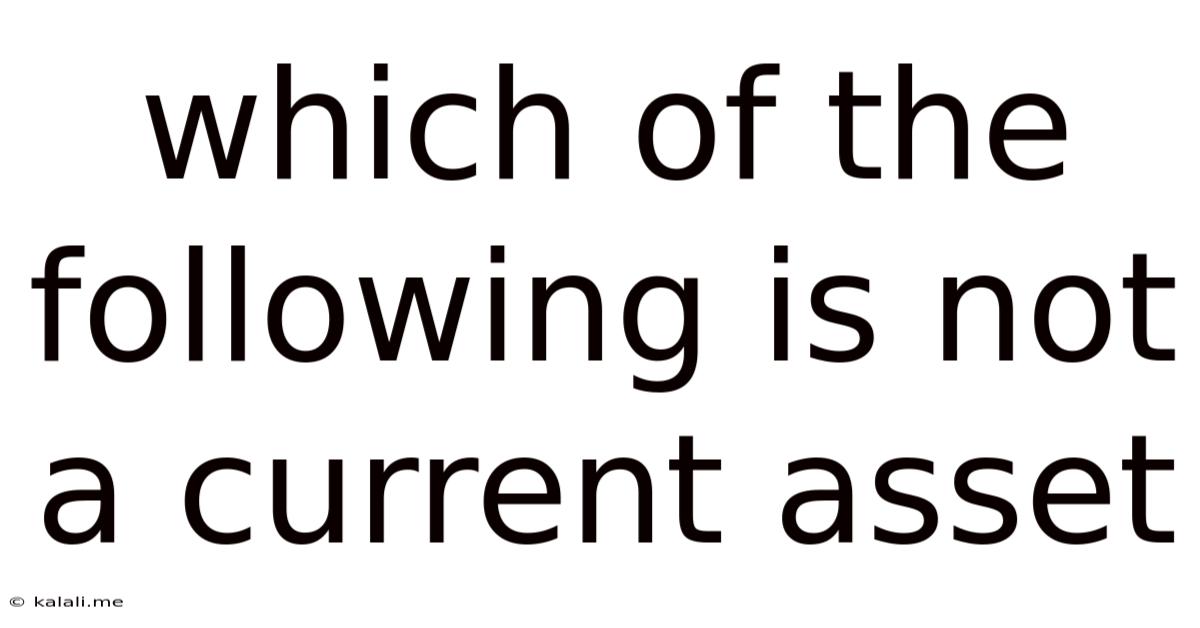Which Of The Following Is Not A Current Asset
Kalali
Jun 11, 2025 · 3 min read

Table of Contents
Which of the Following is Not a Current Asset? Understanding Current Asset Classification
This article will clarify the definition of current assets and help you identify which of several options wouldn't be classified as such. Understanding current assets is crucial for financial statement analysis and accurate business accounting. A clear grasp of this concept is essential for students, entrepreneurs, and anyone interested in financial literacy.
What are Current Assets?
Current assets are assets that a company expects to convert into cash or use up within one year or its operating cycle, whichever is longer. This means they are relatively liquid and play a vital role in a company's day-to-day operations. Examples typically include:
- Cash and Cash Equivalents: This includes readily available cash, money market funds, and short-term, highly liquid investments.
- Accounts Receivable: Money owed to the company by customers for goods or services already provided.
- Inventory: Goods held for sale in the ordinary course of business. This includes raw materials, work-in-progress, and finished goods.
- Prepaid Expenses: Expenses paid in advance, such as rent, insurance, or supplies. These will be used up within the year.
Identifying Non-Current Assets:
Conversely, non-current assets (also known as long-term assets) are assets a company expects to hold for longer than one year. These assets provide long-term value and contribute to the company's future operations but are not readily converted to cash. Examples include:
- Property, Plant, and Equipment (PP&E): This includes land, buildings, machinery, and equipment used in the company's operations.
- Intangible Assets: Non-physical assets like patents, copyrights, trademarks, and goodwill.
- Long-term Investments: Investments held for more than one year, such as stocks or bonds.
Examples and Determining Which is NOT a Current Asset:
Let's consider some examples to solidify our understanding. Suppose you are given a multiple-choice question:
Which of the following is NOT a current asset?
a) Accounts Receivable b) Inventory c) Prepaid Insurance d) Land
The correct answer is d) Land.
Land is a non-current asset because it's not expected to be converted into cash within one year. It's a long-term investment that contributes to the company's overall value but isn't readily liquidated. Options a, b, and c are all examples of current assets due to their short-term nature and expected conversion to cash or use within the operating cycle.
Further Considerations and Context:
The classification of an asset as current or non-current can sometimes depend on the specific circumstances and industry. It's always essential to consider the company's operating cycle when making this determination. A company with a longer operating cycle might classify certain assets as current that another company with a shorter cycle would consider non-current.
Understanding the distinction between current and non-current assets is critical for interpreting a company's financial health and future prospects. By grasping the characteristics of each, you can better analyze financial statements and make informed decisions. Accurate classification is crucial for compliance with accounting standards and provides valuable insights for stakeholders.
Latest Posts
Latest Posts
-
How Many Cups Of Elbow Macaroni Are In A Pound
Jul 01, 2025
-
How Many Guppies In A 5 Gallon Tank
Jul 01, 2025
-
How To Beat Stage 7 In Bloxorz
Jul 01, 2025
-
How Much Oz In A Bottle Of Water
Jul 01, 2025
-
How Long Does It Take To Drive 10 Miles
Jul 01, 2025
Related Post
Thank you for visiting our website which covers about Which Of The Following Is Not A Current Asset . We hope the information provided has been useful to you. Feel free to contact us if you have any questions or need further assistance. See you next time and don't miss to bookmark.